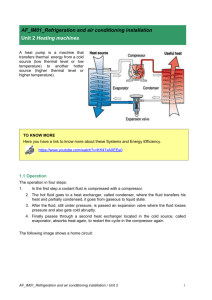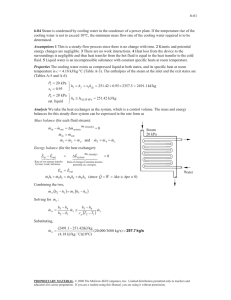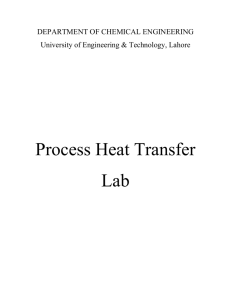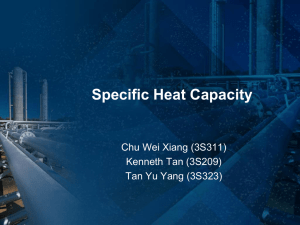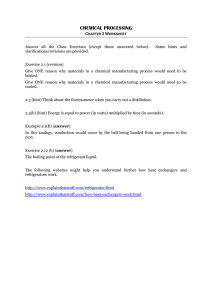2 Heat Transfer
advertisement
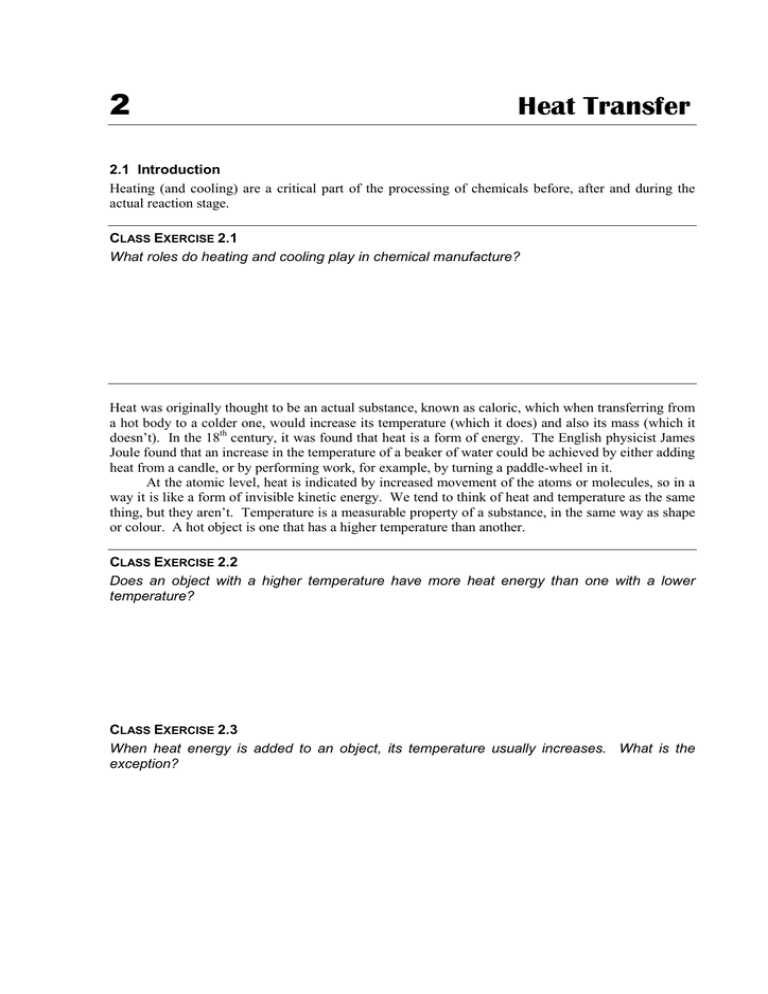
2 Heat Transfer 2.1 Introduction Heating (and cooling) are a critical part of the processing of chemicals before, after and during the actual reaction stage. CLASS EXERCISE 2.1 What roles do heating and cooling play in chemical manufacture? Heat was originally thought to be an actual substance, known as caloric, which when transferring from a hot body to a colder one, would increase its temperature (which it does) and also its mass (which it doesn’t). In the 18th century, it was found that heat is a form of energy. The English physicist James Joule found that an increase in the temperature of a beaker of water could be achieved by either adding heat from a candle, or by performing work, for example, by turning a paddle-wheel in it. At the atomic level, heat is indicated by increased movement of the atoms or molecules, so in a way it is like a form of invisible kinetic energy. We tend to think of heat and temperature as the same thing, but they aren’t. Temperature is a measurable property of a substance, in the same way as shape or colour. A hot object is one that has a higher temperature than another. CLASS EXERCISE 2.2 Does an object with a higher temperature have more heat energy than one with a lower temperature? CLASS EXERCISE 2.3 When heat energy is added to an object, its temperature usually increases. What is the exception? 2. Heat Transfer Apart from the exception outlined above, there is a simple relationship between heat energy added (or removed) and temperature change, as shown below. ∆T = Q mc where ∆T is the change in temperature, Q is the amount of heat of energy added or removed, mass is the mass of the object and c is the heat capacity of the substance. The heat capacity, also known as the specific heat, is the amount of energy required to raise 1 mass unit (g, kg, lb etc) by one degree (Celsius or Fahrenheit). In the unit for specific heat in Table 2.1, the specific heat is the heat energy in Joules required to raise 1 kg of the substance by 1°C. TABLE 2.1 Heat capacities of some common materials (J/kg °C) Substance Heat Capacity Substance Heat Capacity Water 4186 Aluminium 900 Ice 2090 Iron 448 Air 1004 Wood 2800 Concrete 960 Ethanol 2460 CLASS EXERCISE 2.4 (a) Which of the substances in Table 1.3 would show the (i) greatest and (ii) least temperature rise given the same amount of energy and the same mass? (b) What temperature would be reached by 2 L of water at room temperature (20°C), if heated for 1 minute by a 2000W kettle? Assume 80% of the energy is converted to heat that is put into the water. It is hopefully clear that the rate of temperature change for a given object will depend not only on the rate of heating (or cooling), but also on the mass of material and its specific heat. 12 2. Heat Transfer CLASS EXERCISE 2.5 (a) Have you ever noticed how hot the tomato in a toasted sandwich stays? Why should this be? (b) Which of the following objects will increase in temperature at the (a) fastest and (b) slowest rate, given the same rate of heating? • 500 g of water • 250 g of iron • 250 g of aluminium • 500 g of aluminium • 1 kg of ice • 2 kg of air Just as a material with a high heat capacity increases most slowly, the rate at which it cools will also be slower. For example, when you remove a pie from the oven, the contents of the pie, which have a high proportion of water, will remain hot for much longer than the aluminium foil. 2.2 Heat transfer There is one absolute truth about the relationship between heat and temperature Heat energy will flow from a hot object to a colder one, regardless of the sizes of the two objects. CLASS EXERCISE 2.6 If a cup of hot coffee and a cup of iced coffee are placed on a table and left, what happens? How does the heat go from one object to another? There are three basic mechanisms for the transfer of heat: • conduction • convection • radiation EXAMPLE 2.1 (A) A simple analogy helps to distinguish between these mechanisms. Imagine 100 people (representing molecules) in a line having to move a ball (representing heat) from one end of the line to the other. 13 2. Heat Transfer CONDUCTION If you place a metal spoon in a cup of hot coffee, fairly quickly you get a burning sensation in your fingers, because the heat in the drink has transferred itself along the metal. This is known as conduction, and is where the heat energy moves through the collisions of atoms and molecules, “bumping” into one another and so transferring the energy along the material. While all materials can conduct heat, some – for example, metals – are far better than others. In general, conduction only occurs to any great extent in solids, because this is the state where atoms and molecules are closest together. EXAMPLE 2.1 (B) How would conduction be pictured in the situation described in Example 2.1(a)? The rate at which heat is conducted through a material is dependent on: • the type of material • the difference in temperature in the two objects • the surface area of contact • the thickness of the material Rate of conduction = k A (T2 − T1 ) w where A is the surface area of contact, T1 and T2 the temperatures of the two objects, w the thickness of the material through which the heat is being transferred and k the thermal conductivity of the material. TABLE 2.2 Thermal conductivities of selected materials Substance Thermal Conductivity Substance Thermal Conductivity Water 0.35 Aluminium 136 Glass 0.5 Iron 47 Air Concrete 0.015 Wood 0.06-0.08 0.5-0.75 Rock 0.8-2.4 The division between metals and other materials, in terms of heat conduction, is very clear. Nonmetals are known as insulators. CONVECTION In a gas or liquid, the atoms or molecules are too far apart for effective conduction by collision. Movement of the liquid or gas occurs through differences in density between hot and cold zones. A hot liquid (or gas) is less dense than a cool one, and therefore will rise. In doing so, the cool material will sink, therefore setting up a convection current, moving the heat away form the heat source. This can be encouraged to happen more rapidly by mechanical agitation, such as stirring. 14 2. Heat Transfer EXAMPLE 2.1 (C) How would convection be pictured in the situation described in Example 2.1(a)? RADIATION Conduction and convection both require matter – known as the propagating medium – to allow heat transfer. If all heat transfer required a medium, then the earth would be a very cold place indeed, since the heat component of solar radiation would never reach us through the near vacuum that is space. Radiation of heat energy – also called infrared radiation – occurs for any material above absolute zero. The higher the temperature, the more rapid the rate of radiation. This type of heat transfer does not depend on temperature differences, though a cooler object may heat up because it is absorbing more heat than it is radiating. Therefore, a bitumen road on a hot day absorbs heat from the sun, and re-transmits some of that back into the atmosphere. Once the sun goes down, the tar continues to radiate heat until it loses enough to reach an equilibrium temperature with the surroundings. EXAMPLE 2.1 (D) How would radiation be pictured in the situation described in Example 2.1(a)? When heat radiation reaches a surface, it can be absorbed, reflected or transmitted. Only when it is absorbed does an increase in temperature occur. This is why a glass window remains relatively cool even in direct sunlight. The following factors influence the absorption of heat by radiation: • surface reflectivity – shiny surfaces reflect radiation rather than absorb it • geometry of the interaction between radiation and the surface – the more directly the incidence, the more radiation is absorbed • the surface temperature – the hotter the surface, the more it will radiate its heat A oil-filled radiator provides an example of all three types of heat transfer (given the name of the device, it is perhaps not surprising which is the main source of heating): • heat energy is conducted through the metal from the oil to the air in contact with the radiator (or your hand if you touch it) • the motion of the warmer air via convection currents carries heat around the room • the hot radiator radiates heat directly 15 2. Heat Transfer 2.3 Industrial heating and cooling In the laboratory, the common means of heating are a Bunsen burner, a hotplate or a heating mantle. None of these are particularly effective in heating the large volumes inside pipes, reaction tanks and similar industrial plant. The most common means of industrial heating (and cooling) is known as a heat exchanger. They rely on heat being transferred between two fluids which are separated by a conductive layer (eg metal piping). CLASS EXERCISE 2.7 A non-industrial example of a heat exchanger is a car radiator. How does it work? So the basic requirement is that at least of the fluids is in the motion so that fresh heat (very frequently in the form of steam) is brought in or the waste heat is taken away. Figure 2.1 shows the basic principle. fluid being heated heating fluid fluid being heated FIGURE 2.1 The basic mechanism of operation in a heat exchanger CLASS EXERCISE 2.8 What mechanisms of heat transfer allow the heat of the liquid in Figure 2.1? 16 2. Heat Transfer Heat exchangers come in a range of designs, but by far the most common is the shell and tube type, a simple version of which is shown in Figure 2.2. FIGURE 2.2 A shell and tube heat exchanger In a shell and tube exchanger, the two fluids involved are pumped separately, one through the tube system, the other through the surrounding cavity (or shell). In terms of hot and cold, it doesn’t matter which fluid goes where, but a number of other factors can dictate which passes through the tubes (known as tube-side): • the fluid under the higher pressure – to avoid the expense of a high-pressure shell • the fluid most likely to cause build-up of precipitated materials, since the inside of the tubes is easier to clean that the outside • a corrosive fluid – the tubes are easier and cheaper to replace To increase the efficiency of the heat exchanger, multi-pass designs are the norm, where the tube-side fluid travels through the shell at least twice. CLASS EXERCISE 2.9 Modify the diagram below to make a double-pass heat exchanger. The other major design of heat exchangers are plate models. They are consist of a number of very thin corrugated stainless steel heat transfer plates clamped together in a frame. Every second channel is open to the same fluid. Between each pair of plates there is a rubber gasket, which prevents the fluids from mixing and from leaking to the surroundings. Heat is thus transferred from the warm fluid to the colder fluid via the thin stainless steel plate. In most cases the plate type heat exchanger is the most efficient heat exchanger. Generally it offers the best solution to heating and cooling applications since it can better handle the widest pressure and temperature limits. 17 2. Heat Transfer FIGURE 2.3 Flow in a plate exchanger Advantages of a plate exchangers of tube and shell models are: • greater efficiency means smaller physical dimensions for similar performance • any leaks will occur to the outside, therefore being very obvious • extra plates can be added to improve performance • much simpler to maintain and service Disadvantages include: • cannot be used with liquids containing suspended solids, due to clogging • limited pressure capability • not suitable for cooling of gases to condensation point The design of any heat exchanger is such that the two fluids flow in opposite directions. This is known as counter flow, as opposed to parallel flow, as shown in Figure 2.4. (a) (b) Hot fluid Hot fluid Cold fluid Cold fluid FIGURE 2.4 (a) Parallel and (b) counter flow CLASS EXERCISE 2.10 Why is counter flow better? 18 2. Heat Transfer Fouling In normal operation, a build-up of dirt and scale occurs on the heat transfer surfaces. This is a problem because it reduces the flow of liquid and also makes the transfer surface less conductive. This is known as fouling, and can be caused by: • sediment • algae • corrosion • precipitation of carbonates, eg calcium, from hard water Eventually, the fouling becomes sufficiently bad that the heat exchanger must be disassembled and cleaned out. CLASS EXERCISE 2.11 In shell and tube exchangers, it is recommended that the fluid more likely to cause fouling passes through the tubes rather than the shell. Why? Steam as a heat source If heat exchangers are being used to add heat, then something hot must be flowing through the exchanger. That will almost always be steam because: • it has a high heat capacity • it can be easily distributed • its flow is easily controllable • it is non-combustible • it is non-toxic and relatively non-corrosive • it is produced from a cheap and abundant source The steam is generated in a boiler, and can be supplied at above 100°C under pressure. The condensation back to liquid water releases substantial amounts of heat, so temperatures just above boiling point are the ideal. Refrigeration Cooling by conventional heat exchange is relatively limited, so where substantial amounts of heat must be removed, or low temperatures achieved, refrigeration is necessary. Making a body colder is a reversal of the normal heat transfer rule: heat flows from the hotter object to the colder. It is like making water flow uphill. It can be done, but only by the addition of energy. In most refrigeration (and air conditioning) systems – domestic or industrial – the energy is via a compressor, which essentially “squeezes” heat out of a the hot gas, condensing it back to liquid. 19 2. Heat Transfer HOW A REFRIGERATOR WORKS The basic idea behind a refrigerator is very simple: It uses the evaporation of a liquid to absorb heat. The liquid, or refrigerant, used in a refrigerator evaporates at an extremely low temperature, so it can create freezing temperatures inside the refrigerator. There are five basic parts to any refrigerator (or air-conditioning system): • compressor • two sets of heat-exchanging pipes – inside and outside the unit • expansion valve • refrigerant - liquid that evaporates inside the refrigerator to create the cold temperatures The basic mechanism of a refrigerator works like this: 1. The compressor compresses the refrigerant gas. This raises the refrigerant's pressure and temperature (point B – Figure 2.4), so the heat-exchanging coils outside the refrigerator allow the refrigerant to dissipate the heat of pressurization. 2. As it cools, the refrigerant condenses into liquid form and flows through the expansion valve (point C). 3. When it flows through the expansion valve, the liquid refrigerant is allowed to move from a high-pressure zone to a low-pressure zone, so it expands and evaporates. In evaporating, it absorbs heat, making it cold. 4. The coils inside the refrigerator allow the refrigerant to absorb heat, making the inside of the refrigerator cold. The cycle then repeats. Many industrial installations use pure ammonia as the refrigerant. Pure ammonia evaporates at -32°C. CLASS EXERCISE 2.12 (a) Explain how the heat is being transferred “uphill” from the cool interior of the cabinet to the warmer exterior. (b) FIGURE 2.4 Components of a typical refrigerator What would limit the temperature that could be obtained within the cabinet? What You Need To Be Able To Do • define important terminology • distinguish between the three mechanisms of heat transfer • explain how heat and heat removal is applied industrially • explain how refrigeration works 20

